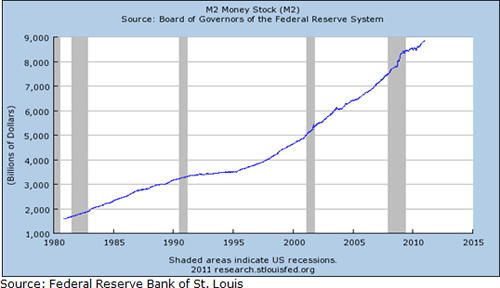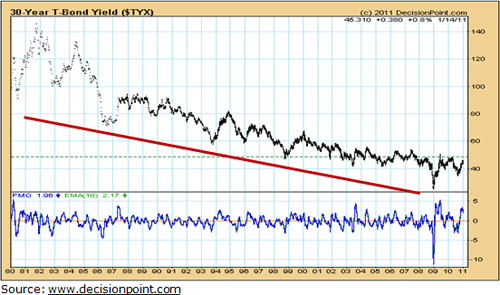Protect Your Wealth from Central Bank Lies on Inflation
Economics / Inflation Jan 19, 2011 - 08:25 AM GMTBy: Claus_Vogt
 If you believe what central banks say and you plan your investments accordingly, you could be in for some big surprises.
If you believe what central banks say and you plan your investments accordingly, you could be in for some big surprises.
Consider, for example, some of the lies spouting forth from the U.S. Fed and the European Central Bank (ECB) …
Lie #1 The Fed Should Aim to Create “At Least Some” Inflation
To justify its latest round of quantitative easing, the Federal Reserve has made the case that inflation in small doses is good … even if larger doses are obviously bad.
In reality …
- No economist has ever presented a shred of evidence that establishes the dividing line is between “a little good inflation” and “a lot of bad inflation.”
- Moreover, no economist can deny that inflation almost always feeds on itself, as each player in marketplaces seeks to gain an advantage over the other, jacking up prices in a leapfrog fashion.
- Indeed, past experience proves that rampant, out-of-control inflation almost invariably starts with small brushfires and then escalates into major conflagrations, and
- Any central banker who denies these realities is merely compounding the first lie with still another.
Lie #2 Modern Central Banks Pursue “Price Stability”
Every central bank pays lip service to price stability as its core mission and goal, but most are surprisingly quick to make a wide range of excuses when that goal slips them by.
Case in point: The European Central Bank (ECB) swears that its goal is to keep price inflation capped at 2 percent per year. But last week, the inflation rate in the euro zone busted through that threshold at 2.2 percent, the highest in two years.
And still, they talk unabashedly about price stability.
Think about that for a moment. If prices rise 2 percent each year, they will jump nearly 22 percent after ten years with compounding.
After 20 years, prices will be up 48.6 percent, and at a 2.2 percent annual rate, they’ll be up by 54.5 percent. That’s not exactly price stability.
Isn’t it strange — no, cheeky and reckless — to define a one-third-or-more loss in your wealth as “price stability”? Of course it is. But it’s part of the central banking community’s dirty little secret.
Let me remind you that the U.S. Fed and other central banks are no better than the ECB, often even worse. And in our globalized world with monetary and fiscal “crisis management” so synchronized, inflation is a global phenomenon.
Indeed, a few months ago, inflation started to rear its ugly head in China and other emerging nations. Now it has reached Europe. And it’s only a matter of time before it hits U.S. shores. So everything I am writing here is equally pertinent to the U.S.
Lie #3 Economic Growth Drives Prices Higher
This was the recent headline in a major German newspaper commenting on the higher European and German inflation rates.
The intent was to put a positive spin on the higher inflation, directly associating it with positive growth, and it’s exactly what modern central bankers want you to believe.
Don’t fall for it.
To understand why, go back to a couple of basic definitions of inflation.
The first definition:
Inflation is the increase in the general level of prices of goods and services in an economy over a period of time.
True, but this is merely a description. It tells you nothing about what causes rising prices. So if you rely exclusively on this definition, you are more likely to fall for the argument that it’s all driven by economic growth or some other easy-to-blame — supposedly “temporary” — factor like rising energy and food prices.
So while formally correct, this definition isn’t very helpful. It hides more than it clarifies.
The second definition:
Inflation is the increase in the money supply in an economy over a period of time.
Now, we’re getting down to the heart of the matter: This definition makes it clear that rising prices are merely a symptom of the true inflation — the expansion in the money supply. And it also makes it immediately clear that the primary culprit for rising inflation is the entity in charge of that money supply — the central bank.

Coming to the Truth
Now, when measured by this criteria — expanding money supply —the true role of central banks is unmasked. Instead of inflation fighters, they are revealed as inflation mongers.
Indeed, history shows that sustained inflation — let alone rampant or hyperinflation — has never been possible without a huge increase in the money supply. And common sense tells you that it will never be possible in the future either.
What, then, gives politicians and central bankers the cover to perpetuate their lies?
The answer is time lags!
It takes time for expanding money supply to feed through the economy and create inflation.
And sometimes, as in recent history, money supply growth leads to rising prices in sectors that are not adequately reflected in consumer price indices — like stocks in the late 1990s and real estate in the early 2000s.
Some of the best evidence on the importance of money supply lies in the studies of historical inflations conducted by Swiss economist and monetary expert Peter Bernholz in his book Monetary Regimes and Inflation.
His findings:
- All major inflations have been caused by princes or governments.
- All hyperinflations have occurred in the presence of “discretionary money regimes” — in other words, when central banks had the freedom to run the printing presses.
- Hyperinflations are always caused by public budget deficits which are largely financed by money creation. If inflation accelerates, these budget deficits tend to increase.
On the Path to High Official Inflation Rates
Please consider the above findings very seriously because they are a far more accurate description of our current monetary and fiscal environment than anything you will hear from the Fed or other central banks.
So it’s no coincidence that consumer price inflation has started to creep up. It’s exactly what our politicians have ordered when they decided that you, the taxpayer, should be handed the bill for the sins of reckless bankers and real estate speculators.
With Fed Chairman Ben Bernanke the world’s leader of “modern central banking” …
With governments all over the world on a debt binge …
And with still more of the same in the pipeline …
You had better brace yourself for more inflation.

How to Protect Yourself and Profit From Higher Inflation Rates
One of the first markets to respond to present and future inflation is the bond market. Bond investors foresee inflation driving interest rates higher. They don’t want to get stuck in fixed, low-yielding bonds. And they sell.
So here’s what to do.
First, get rid of your long-term bonds. They are definitely not the place to be in inflationary times. And with rates as they are now, long-term Treasury bonds look very risky.
Indeed, right now, long-term interest rates actually seem to be in the process of forming a huge bottom formation. The decades-long trend of declining interest rates which began in 1981 is probably turning around. A new bull market in interest rates (bear market in bond prices) is now beginning.
Second, if your portfolio or your business are vulnerable to higher interest rates, you should hedge. In the past, there was little you could do other than run for cover. Fortunately, however, in today’s markets you can protect yourself with ETFs like ProShares UltraShort 20+ Year, symbol TBT, designed to rise 2 percent for every 1 percent decline in bond prices.
Third, if you have funds you can afford to risk, consider ETFs like TBT as a vehicle to profit directly from rising interest rates.
Fourth, if you haven’t done so already, learn more about the dangers and opportunities ahead in my just-published book, The Global Debt Trap. Click on your choice of bookseller to order it online — Amazon, Barnes & Noble or Books-A-Million or stop by your nearest bookstore.
Best wishes,
Claus
This investment news is brought to you by Money and Markets. Money and Markets is a free daily investment newsletter from Martin D. Weiss and Weiss Research analysts offering the latest investing news and financial insights for the stock market, including tips and advice on investing in gold, energy and oil. Dr. Weiss is a leader in the fields of investing, interest rates, financial safety and economic forecasting. To view archives or subscribe, visit http://www.moneyandmarkets.com.
© 2005-2022 http://www.MarketOracle.co.uk - The Market Oracle is a FREE Daily Financial Markets Analysis & Forecasting online publication.



